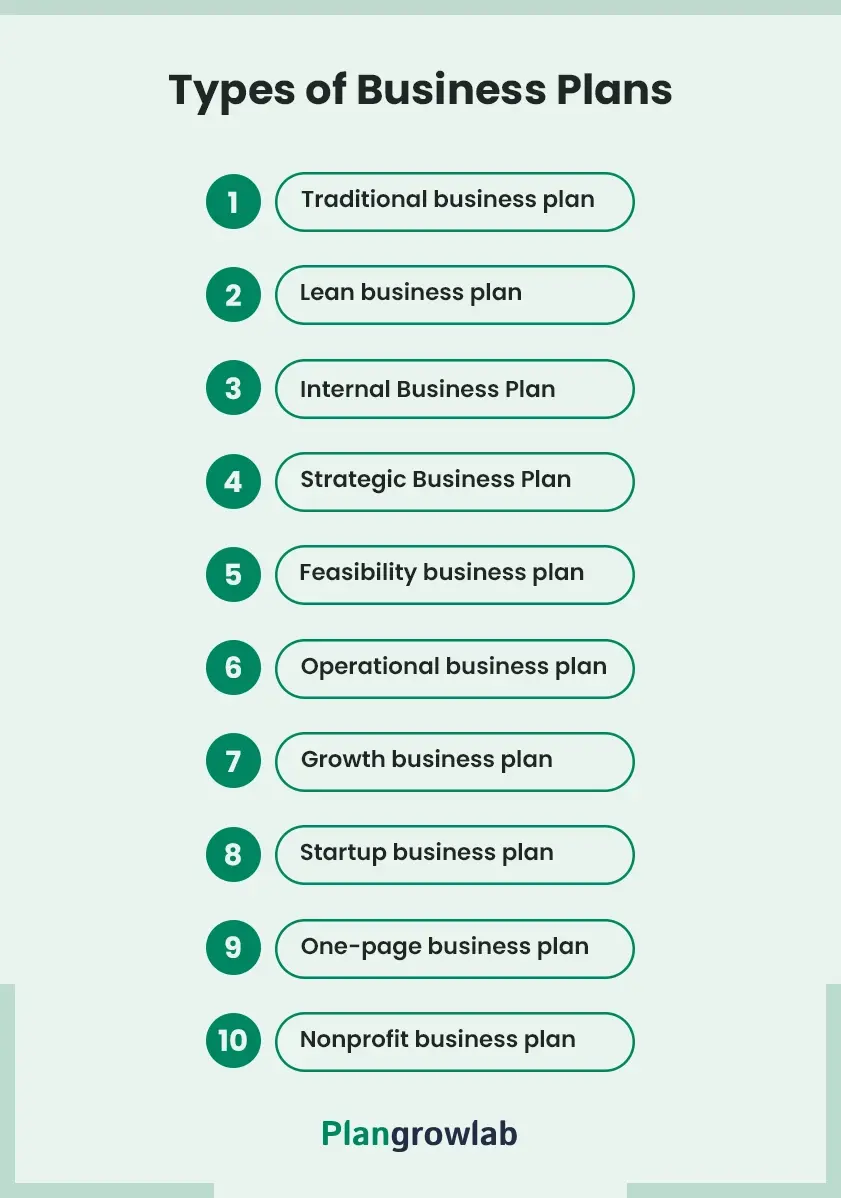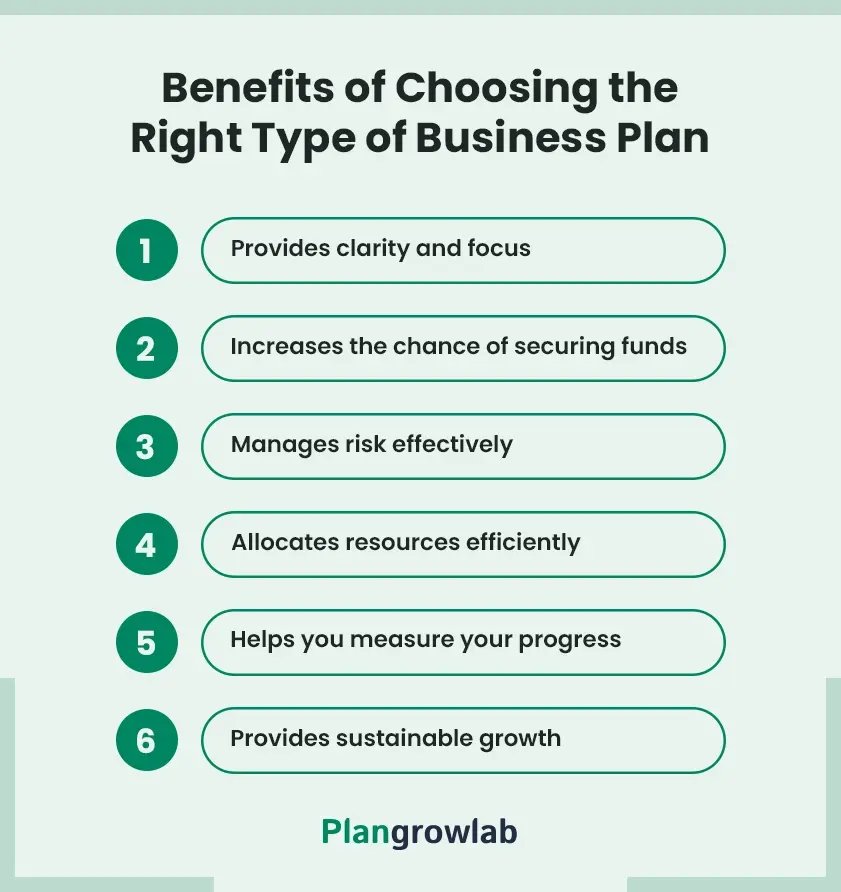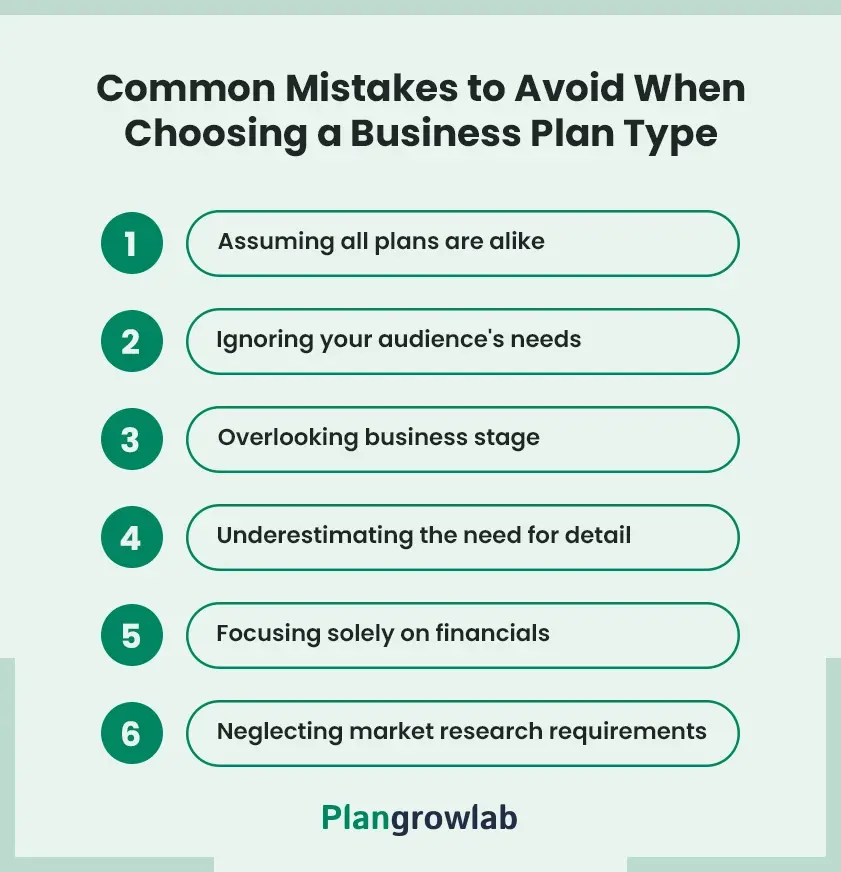One of the first things we tell clients is this: A business plan isn’t one-size-fits-all. The type of plan you need depends entirely on your goals, audience, and stage of business.
And that’s exactly where most founders get stuck. Almost every week, we meet people who sit down to “write their business plan,” only to freeze before typing the first line.
They’re not sure where to start, what to include, or even what kind of plan will work best for them. Without that clarity, the process becomes overwhelming fast.
We’ve seen this play out with both first-time founders and established business owners. Some need a detailed, investor-ready plan to raise funding. Others just need a lean roadmap to steer internal decisions. Most can’t tell which one will actually move their business forward, and that’s where planning stalls.
In this article, we’ll break down the different types of business plans we use with clients.
What is a Business Plan?
A formal document that outlines your business strategies, target market, and financial projection to achieve your business goal is known as a business plan.
A well-crafted business plan serves as a roadmap for your business growth on how you’ll achieve your objectives over a specific period.
Remember, it’s a living document that needs updating as your business grows. Different plans, such as traditional, lean, and strategic, suit various stages of business development. Hence, understanding why these different types exist and what their purposes are is essential for selecting the right plan for your needs.
So let’s explore the next section for a better understanding.
Need A Solid Business Plan For Your Business Idea?
Get in touch with us. We’re a business plan consulting company that helps hundreds of businesses achieve their business goal with solid planning.
Why do different types of business plans exist?
Here are reasons why there exist different business types:
Varied business goal
Businesses have diverse goals beyond just increasing sales and profit. They may focus on expanding their market reach or even enhancing brand awareness. Thus, each of these goals requires a different approach and strategies.
From our consulting work, we’ve seen plans fail simply because they were built around the wrong goal. A plan aimed at scaling fast looks very different from one aimed at stabilizing operations.
Different business stages
There are different types of business plans for startups and established businesses. A startup requires a business plan from scratch to outline its vision, secure funding, and validate its business idea.
Meanwhile, an established business needs a solid plan to focus on growth strategies, streamline operations, or even pivot into new markets.
Separate target audience
Business plans are tailored depending on whom you’re targeting. Whether they’re investors, partners, lenders, or internal teams.
Each audience demands a different style and focus, with changes in content and presentation to effectively communicate the business's goals and needs.
Distinct level of detail
A healthcare business requires an in-depth explanation of its operation and research hence the level of detail is high.
In contrast, a startup requires a more straightforward plan focusing on its core business idea, marketing plan, and basic startup costs and projections. Resulting in less detail.
The level of detail varies based on the industry complexity and specific business needs.
Constant evolving business growth
As market conditions change, businesses need adaptable plans that evolve with their strategies. Staying competitive requires new approaches to stay ahead in a dynamic market.
One of the biggest mistakes we see is treating a business plan as a “done once” document. In reality, the best plans are living documents that evolve as your market and strategy change.
That’s about it. Now, let’s explore the different business plans.
Types of business plans
Here are the 10 types of business plans designed to address different needs and stages of business growth. Each type serves a unique purpose and provides a different level of detail.

1. Traditional business plan
| When Needed | Starting a new business, seeking investment, or applying for a loan |
| Typical Spanning Length | 20 to 50 Pages (Approximately) |
| Audience | Investors, lenders, and stakeholders |
| Level of Detail | High level of detail |
| Purpose | To secure funding and provide a clear business roadmap |
Traditional business plans serve as the foundation for many entrepreneurs and growing businesses.
Its primary aim is to provide detailed insights into the business nature, market position, and competitive advantages. Such insights help businesses craft a roadmap that offers growth, development, and prosperity to businesses.
Here are key components that are commonly included in a traditional business plan:
- A high-level overview (executive summary) of the business that includes the company’s mission, product or services, and key financial information.
- The business description provides detailed insights into the business's nature, market position, and competitive advantages.
- A market analysis that provides data on the industry landscape, target market demographics, and competitive analysis.
- Forecasts of revenue, expenses, and profitability to demonstrate financial viability.
- A description of your company's structure, management team, and key personnel.
- Your estimated income, expenses, and cash flow for the next several years.
2. Lean business plan
| When Needed | When time is short and quick action is needed for startups or small businesses |
| Typical Spanning Length | 1 to 5 pages (Approximately) |
| Audience | Internal teams, business owners, or investors |
| Level of Detail | Low to moderate |
| Purpose | To streamline planning, allow flexibility, and quickly adapt to changes |
Unlike a traditional business plan, which can be lengthy and complex, a lean business plan typically fits on one page.
It’s a simplified version of a traditional business plan that focuses on key elements like business model, target market, and essential finance.
A lean business plan is typically crafted for internal purposes or when experimenting with new products, services, or markets. The goal is to create a plan and immediately execute it to see if it succeeds.
Key features of a lean business plan are:
- Lean business plans focus on being short and to the point.
- They use bullet points and tables to share key information quickly and clearly.
- Lean business plans are designed to be easily updated as the business evolves, which allows for quick adjustments.
- A lean business plan focuses on practical steps like setting milestones and tracking performance to help businesses make smart decisions.
We’ve used lean plans with clients who needed to validate ideas fast, often before spending a single dollar on product development. The lean format lets you move quickly without skipping the essentials.
3. Internal Business Plan
| When Needed | When businesses need to align their teams, manage resources, and implement new strategies |
| Typical Spanning Length | 5 to 15 pages (Approximately) |
| Audience | Internal teams, managers, and employees |
| Level of Detail | Moderate |
| Purpose | To streamline operations and provide clarity over internal goals. |
The internal business plan is a strategic document that aims to bring management and employees on the same page and focuses on a common goal.
It’s designed to ensure that all team members understand their roles and stick to the roadmap to achieve the organization's vision effectively.
Additionally, the internal business plan outlines the resources available to the business. An internal business plan includes:
- Detailed plans for how to achieve those goals through day-to-day operations.
- Identification of potential challenges and strategies to mitigate them.
- Key performance indicators (KPIs) to track progress and success.
- A schedule outlining when key milestones will be achieved.
- Clarification of who is responsible for each part of the plan.
- Insight into the internal market dynamics.
4. Strategic Business Plan
| When Needed | When an organization aims to set long-term goals |
| Typical Spanning Length | 10 to 30 pages (Approximately) |
| Audience | Senior management, stakeholders, and board members |
| Level of Detail | High |
| Purpose | To outline the company’s long-term vision and mission |
A strategic business plan is a comprehensive document that outlines an organization's long-term goals and the strategies to achieve them.
It acts as a roadmap for decision-making, that helps your businesses align their resources and efforts with their overall vision.
The features of a strategic business plan include:
- Specific deadlines for achieving short-term and long-term objectives.
- Defines the business vision and states the mission statement.
- In-depth study of market trends, competition, and opportunities.
- Plans for allocating financial, human, and operational resources.
- Identification of potential risks and mitigation strategies.
- Strategy for differentiating the business in the market.
- Step-by-step plan to execute strategic goals.
5. Feasibility business plan
| When Needed | To evaluate the viability of a new business idea or project before committing significant resources |
| Typical Spanning Length | 10 to 15 Pages (Approximately) |
| Audience | Entrepreneurs, potential investors, management, and stakeholders |
| Level of Detail | High level of detail |
| Purpose | To assess whether a proposed idea or project is viable |
A feasibility business plan is a document or a plan that determines the practicality of a new business idea. It's a crucial step before investing significant time and resources into a venture.
A feasibility business plan helps entrepreneurs assess whether their proposed product or service has the potential to succeed in the market.
The feasibility business plan typically includes:
- A brief overview of the business idea, target market, and key financial projections.
- Details about the proposed offering, including its unique features and benefits.
- An assessment of the target market size, customer needs, and competition.
- An outline of the resources, processes, and infrastructure required.
- Identification of potential risks and mitigation strategies.
We always recommend feasibility plans for big moves like new products, market expansions, or large investments. It’s much cheaper to kill a bad idea on paper than in the real world.
6. Operational business plan
| When Needed | To outline the day-to-day operations of an existing business |
| Typical Spanning Length | 20 to 40 Pages (Approximately) |
| Audience | Internal teams, department heads, managers, and staff |
| Level of Detail | High level of detail |
| Purpose | To manage daily activities effectively |
An operational business plan is a detailed blueprint that outlines the specific actions and processes necessary to achieve an organization's strategic objectives.
It focuses on the internal operations of the company, including production, sales, marketing, and human resources. The purpose of operational planning is to streamline internal operations to achieve the desired goals effectively.
The operational business plan's purpose is to bring all team members on the same page and make them understand their roles and responsibilities in executing the company's goals.
Here are the key components of an operational business plan:
- Details the processes involved in producing goods or services, including equipment, materials, and staffing requirements.
- It clearly defines the roles of each team member, ensuring accountability and minimizing overlap in duties.
- Includes key performance indicators (KPIs) to measure progress and success.
- Explains the process of sourcing materials, managing inventory, and distributing products or services.
- Identifies potential risks and outlines strategies for mitigating them.
- Describes the technology infrastructure, systems, and software needed to support the business's operations.
- Outlines the strategies for reaching and acquiring customers, including sales channels, marketing campaigns, and pricing.
Operational plans are where we see the most overlooked opportunities. When done right, they not only align teams but also reveal inefficiencies that directly save money.
7. Growth business plan
| When Needed | When an existing business aims to expand business operations, enter new markets, and launch new products |
| Typical Spanning Length | 15 to 20 pages (Approximately) |
| Audience | Investors, management, and stakeholders |
| Level of Detail | Moderate |
| Purpose | To outline strategies to achieve growth and identify potential opportunities in the market |
A growth business plan outlines the necessary steps required to advance current business operations to achieve desired business goals. It serves as a roadmap for businesses looking to increase their market share, revenue, or customer base.
Importantly, a growth business plan focuses on identifying growth opportunities, developing strategies to capitalize on them, and allocating resources to support expansion.
The key components of a growth business plan include:
- Documents that examine the target market, including size, growth potential, and competition, to identify expansion opportunities.
- Blueprint that helps you identify the unique value proposition and competitive edge.
- Specific strategies for expanding the business, such as new product development, geographic expansion, or mergers and acquisitions.
- Updated financial forecasts that reflect the impact of growth.
- A clear roadmap for executing growth strategies, including timelines, resources, and key performance indicators (KPIs).
8. Startup business plan
| When Needed | When launching a new business or seeking funds from investors |
| Typical Spanning Length | 15-25 pages (Approximately) |
| Audience | Investors, lenders, and potential partners |
| Level of Detail | High level of detail |
| Purpose | To outline business idea, demonstrate viability and secure funding |
A startup business plan is a foundational document that provides detailed information on the vision, objectives, and strategies for launching a new venture.
It serves as a roadmap for entrepreneurs, detailing everything from the business concept, techniques to deal with challenges to financial projections and growth plans.
The common components of a start up business plan include:
- Overview of business that includes your mission, product or services, target market, and financial goals.
- A detailed explanation of what the startup does, its unique value proposition, and how it solves a customer's problem.
- Detailed information on the company's structure, management team, and key personnel.
- The plan for reaching and attracting customers.
- Detailed forecasts of revenue, expenses, and profitability over a specified period
- An outline of the capital needed to launch and what are the sustainable ROI.
- An explanation of the required resources, the duration for which the funds will be necessary, and how they’ll be utilized.
9. One-page business plan
| When Needed | When a quick overview is needed for initial pitches or discussion |
| Typical Spanning Length | 1 page |
| Audience | Investors, stakeholders, and team members |
| Level of Detail | Low |
| Purpose | To provide a clear and quick snapshot of business concepts, goals, and strategies |
A one-page business plan is a small version of the traditional plan that provides a quick overview of the business.
The purpose is to provide key information about the business clearly, which makes it easy for others to understand and make decisions quickly.
This format lets you quickly share your vision, strategies, and goals without overwhelming potential investors or stakeholders with too much detail.
The features of the one-page plan include:
- A short introduction to your business that includes mission, products or services, target market, and financial goals.
- A clear statement of the problem your business solves and the unique solution you offer.
- Overview of your target market, competitors, and industry trends.
- A brief introduction to the key members of your management team.
- If seeking funding, outline the amount requested and how the funds will be used.
10. Nonprofit business plan
| When Needed | When launching a new nonprofit business |
| Typical Spanning Length | 15 to 30 pages (approximately) |
| Audience | Donors, grantmakers, board members, and community stakeholders |
| Level of Detail | Moderate to high |
| Purpose | To outline the nonprofit’s mission and goals and attract funding to achieve social objectives |
Nonprofit organizations develop nonprofit business plans to achieve their social objectives. It serves as a roadmap for the organization, detailing how it intends to achieve its objectives, attract funding, and measure its impact.
The key components of a nonprofit business plan include:
- A clear and concise statement of the organization's purpose and goals.
- Detailed information about the programs and services offered.
- Identification of the specific groups or communities the organization serves.
- Plans for generating revenue, including grants, donations, memberships, and fundraising events.
- A summary of the organization's board of directors, management team, and governance policies.
- Estimated income, expenses, and cash flow for the next several years.
In nonprofit plans, impact metrics matter as much as financials. We’ve seen funders reject well-written plans simply because they didn’t explain the tangible change the nonprofit would create.
That said, let's see...
How to choose the right business plan type for your needs?
For a successful business plan, here's how to make an informed decision:
Understand your purpose
First, choose the right business plan to clarify your purpose. To do so, ask yourself what you want to achieve with the plan and why your business needs one.
Here are some aspects you should clear before you choose your plan:
- Is your goal to secure loans or attract investors?
- Are you aiming to expand your current business?
- Do you need a plan to guide your team and streamline operations?
- Are you exploring a new idea or project or thinking of launching a new product?
Consider your audience
Always consider to whom you’re addressing and what’s the purpose of addressing your business plan. Check out whether the business plan is for an investor, partner, lender, or internal team. Different audiences require different information and presentation styles.
Access your business scope
The complexity and scale of your business also influence the plan type you should choose. Hence, consider the following factors before choosing:
- Think about your business stage—whether you’re a startup, an established firm, or an expanding business.
- Evaluate your market size—if it's highly competitive, you'll need a detailed, analytical plan, while a smaller market may require a simpler approach.
- Look into your product and service—They dictate the plan type. Every product and services need a different plan and strategies to move in the market.
We’ve had clients in niche markets where a lean, focused plan was perfect. But in crowded industries like SaaS or food & beverage, you can’t skip detail. Investors in those spaces expect you to show deep market analysis and a strong competitive edge.
Focus on the right format
Different business plans have different formats, each serving a specific purpose. Always choose the format based on your audience.
For example, a one-page plan works for quick overviews, while a detailed plan is better suited for investors or lenders looking for in-depth insights.
However, consider the following aspects when choosing a business plan format:
- Audience you are addressing
- Font and layout choices
- Presentation style
- Length of the plan
- Presentation tone
When we prepare plans for clients, we sometimes create two formats: a short “door-opener” version for quick conversations and a full, detailed version for deeper investor discussions. That flexibility often makes all the difference.
Benefits of choosing the right type of business plan
Choosing the right business plan is crucial for success and offers several key advantages:

Provides clarity and focus
A well-chosen business plan provides clarity about your goals and strategies. It helps you define your mission and ensure that all team members are on the same page, focusing on the same business objective.
Increases the chance of securing funds
Investors and lenders expect detailed plans that show a clear grasp of the market, competition, and financial forecasts. A well-tailored plan boosts your chances of securing capital by highlighting your readiness and dedication to success.
From our experience, investors rarely fund “generic” plans. When a plan is clearly built for its funding purpose with relevant numbers, realistic forecasts, and proof you understand your market, it changes the conversation from “maybe” to “let’s talk.”
Manages risk effectively
With a solid plan, your business can prepare for unexpected challenges and remain resilient, even during tough times. Plus, with the latest technologies in your business plan, you can forecast potential risks, allowing you to be prepared in advance.
Oftentimes, we stress-test client plans against “what if” scenarios—market dips, cost spikes, competitor moves. Businesses that have thought through these scenarios in their plan tend to recover faster and avoid expensive mistakes.
Allocates resources efficiently
Right business planning enables your business to allocate resources efficiently, leading to better returns. It ensures your time, money, and manpower are used efficiently and effectively to achieve your goal within the time and budget.
Helps you measure your progress
With a clear business plan in place, you can set specific milestones and performance metrics. Such milestones enable you to track your progress over time and make adjustments as needed.
In consulting sessions, we remind clients: “If you can’t measure it, you can’t manage it.” The right plan gives you a yardstick for success so you can tell if you’re moving forward or drifting off course.
Provides sustainable growth
A common business plan can help you reach your goals, but choosing the right plan specifically tailored to your business ensures sustainable growth. It keeps your business on track, leading to steady growth and development.
Common mistakes to avoid when choosing a business plan type
Avoiding these common mistakes can help you create an effective document that will enhance your credibility and build a solid foundation to reach your goal:

Assuming all plans are alike
Treating all business plans as interchangeable or the same can lead to selecting one that doesn’t fit your specific needs or objectives.
Ignoring your audience's needs
Failing to consider who will read the plan may result in a format or content that doesn’t resonate with stakeholders. This mistake will not convince investors and destroy your credibility.
Overlooking the business stage
Not matching the plan type to your business stage (startup, growth, etc.) can lead to inappropriate detail or a lack of necessary information. A startup business plan won’t effectively support the growth of your existing business.
Underestimating the need for detail
Opting for a lean or one-page plan when more detail is necessary can hinder your ability to secure funding or support. Hence, ensure you add the required information properly to persuade investors, external and internal stakeholders, or any other reader.
Focusing solely on financials
Choosing a plan type that focuses too much on financial projections while neglecting operational plans can lead to an incomplete picture. This may raise doubts among investors and negatively affect your chances of securing funding.
In our reviews, we’ve flagged multiple plans that had solid numbers but no real strategy to deliver those numbers. Investors see that gap instantly and start questioning your execution capability.
Neglecting market research requirements
Choosing a plan type that doesn’t require thorough market analysis can leave you unprepared for competition. The lack of preparation can hinder your ability to adapt and respond effectively to market dynamics.
Conclusion
Now that you know the business plan types and how to choose the right one, you can achieve your business goals effectively.
However, if you need further assistance to craft your business plan, you may get in touch with our business plan consulting company.
Our qualified business plan experts can help you create business plans, ensuring you choose the right type tailored to your specific business needs.
Get your business plan ready today!
Frequently Asked Questions
What is the difference between a traditional business plan and a lean business plan?
A traditional plan is a detailed and comprehensive documents that explain each aspect of the business in detail. Often 20 to 50 pages.
A lean business plan, on the contrary, is a shorter document (can be a page long) that focuses on key aspects of businesses, market opportunities, and financial viability.
When should a startup use a feasibility business plan?
Startups should use a feasibility plan to determine if their idea is viable and can generate enough revenue to witness the company’s success. It’ll help startups to gauge the potential of their business idea and identify potential challenges or obstacles they may face.
What is the purpose of a strategic business plan?
A strategic business plan aligns business resources with long-term goals and sets the direction for achieving them. It helps businesses equip resources to the right person, at the right time, to achieve business objectives.
How many types of business plans are there?
There are several types of business plans; however, the core 7 types include traditional, startup, feasibility, one-page plan, operational or operations plan, exit strategy, and internal business plan.


